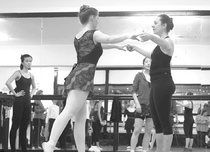Interview
with Franziska Rosenzweig - Ballet and Pilates Teacher - creator of Holistic Ballet®
Franziska: Getting injured is one of the greatest worries of every dancer. It can make or break one's career. A healthy body is not just crucial for professional dancers, whose livelihoods depend on it, but also for amateurs whose joy of practice and safe progress can be compromised by consistent pain.
Holistic Ballet training is designed and structured to minimise the risk of injuries. But when they do happen, it is important to understand what is going on and how to deal with them. Since I am not an expert in this field, I interviewed my friend and colleague, Daniel Schwager, physical therapist and acupuncturist, who treats professional and amateur dancers at his clinic at Natureworks for more than 20 years, on this subject.
Franziska: Hello Daniel, can you explain to us what an injury actually means?
Daniel: I believe with 'injuries' we mean in our context musculoskeletal injuries, that may be caused by and affect our body’s movement in our dance practice.
This generally implies injuries to muscles, tendons, ligaments and maybe discs, which may affect nerves and blood vessels, causing pain, discomfort and restrictions in movements.
Franziska: What are the different kinds of injuries we should know about?
Daniel: From my experience of working as a physical therapist with dancers, I would broadly divide musculoskeletal injuries into:
A) Acute Trauma Injury from an impact or accidents, like falls, twisting an ankle, uncontrolled over-stretching and so on.
B) Repetitive Stress Injury often chronic, often ‘coming and going’, but never really disappearing. Often from ‘no obvious causes’, but mostly from excessive overuse or repeated misuse or stress on the body through poor technique, over-enthusiastic, too much and too hard training, lack of warm up and inadequate recovery time.
In order to successfully deal with the injury we have to understand the ‘Why’.
Franziska: Do you mean the cause of the injury?
Daniel: Well, I am not sure if the ‘cause’ is the right terminology here and personally I don’t like it.
The cause of an Acute Trauma Injury, can be very personal according to our own believes. The cause of a Repetitive Stress Injury can be confusing and difficult to understand.
I am thinking more, “What is the underlying problem of the injury or pain?”
Franziska: explain…
Daniel: I mean, when a dancer has an accident or twist an ankle, at the wrong time in their career or in life, that causes pain and frustration, maybe even anxiety about loosing their job with a dance company, their mind wonders and they looks for all sort of causes. ‘wrong shoes or wrong floor, bad luck or bad karma?’
All I have learnt, without trying to be god, is that Acute Trauma Injury often happens when we are tired of fatigued, have other stresses going in our lives and so on, but most importantly when there is an underlying and hidden Muscular Imbalance that interfears with the natural functionality of our body.
I strongly believe that Muscular Imbalances are the breeding ground for injuries, the cause for postural misalignment, restrictions and bad habitual movement patterns, therefor they are the reason for most of our Repetitive Stress Injury and chronic pains.
Franziska: What are Muscular imbalances and how do they develop?
Daniel: Muscular Imbalances are imbalances in muscle strength, length and use. For example the inner thigh muscle is weaker and outer muscle is stronger, often the cause for knee problems. Or the one side of the hip muscle is tighter than the other, often the cause for pelvis misalignment.
Most Muscular Imbalances develop while we grow up and aquier new movement and new tasks. We all have Muscular Imbalances otherwise we would not favour one body side over the other when we playing tennis, crossing over legs when we sit, using the mouse at the computer or just putting the kettle on. Most of them even do use a favour, by giving us the habitual movement patterns we subconsciously use in our daily activity, allowing us to move freely and even multi tasking to great efficiency.
The problem is when we start to alter our daily activity, increase its intensity or start doing something with our body that it is not used to.
Franziska: What is the first thing we should do when we have an accident, an acute- or trauma injury?
Daniel: The first thing you do is R.I.C.E = Rest - Ice - Compress - Elevate, to reduce the pain and to minimise the swelling. Keep icing for 10-20 minutes at a time during the
first 24 hours after the accident.
It is also good to take a painkiller to help us to relax and to avoid contracting the muscles of the injured area so that blood can flow to the area where it is needed. We will also be less
likely to adopt compensation patterns that can cause further problems.
Once the first signs of acuteness, like swelling, have gone down, and before going back to class, I would strongly advise seeing a therapist to assess the situation and to develop a treatment plan. One can do a lot of damage in the wrong management of an injury and cause future problems.
Injury management is important and the dancer and therapist should work together to design a recovery plan, of when and how best to get back to class.
Franziska: When should we use heat?
Daniel: After the initial stage of an acute injury, generally we say after 24 to 72 hours.
In order for an injury to heal it needs blood circulation and that is increased with the application of heat, either with a hot water bottle or heat cream.
Personally I don’t like the application of ice on a chronic injury, as it can mask the problem by numbing the pain and therefore taking the dancer even further away from the healing process.
Franziska: How should we deal with the perhaps more common chronic injuries you call 'overuse or repetitive stress injuries'?
Daniel: Those injuries are more difficult to deal with, as they do not cause severe pain as an acute injury. It is the niggling pain that comes and goes but never really disappears
completely, and that many dancers chose to ignore. Until one day they may reach for the toothbrush and their back spasms or they may lift the legs in class and ‘ping’ the hamstring goes.
It is important to understand how those injuries or conditions develop. Every time we do a dance practise, we possibly cause micro-injury to our body that would need time to heal. The recovery
time depends on the severity of the micro-trauma, age and general health of the person. Kids may require a day, adults two and older dancer maybe three days to recover.
If we do not allow sufficient rest, we pile micro-trauma on top of micro-trauma, preventing the body’s own healing process and creating further muscular imbalances and disorders.
Basically, pain is experienced when we cause ourselves damage or a damaged area is repeatedly aggravated or re damaged. This maybe just on a micro level, but it needs time to heal.
Doing the same painful thing over and over again without a recovery phase will develop chronic problems, repetitive stress or overuse injury, and compensation patterns that cause further strain and stress and are the breeding ground for new injuries, often described as 'injury without any obvious cause'.
Franziska: As a ballet teacher and Pilates instructor I know that building balanced strength and mobility is key to rehabilitating and preventing (further) injury. What is your
approach as a therapist?
Daniel: I strongly believe in Injury Management.
The problem is that most dancers never want to stop! They are used to pain or even think it must be painful in order to feel that they work hard enough or feel good about themselves.
They want to get back to class immediately with the expectation of training at the same level as before the injury happened. Instead, one should learn from the injury, increase one's body awareness and learn to listen to the signals of the body.
Sometimes I assess an injury, for example a twisted ankle, where it becomes obvious that the problem is not only the ankle ligament but also the surrounding muscles that are overly tight and stressed. The therapist can manually release the tight muscle, but the dancer has to get involved in stretching and strengthening exercises and needs to learn which movements are ok to do and which ones are not.
When we have a muscle tear, fibrous tissue and adhesions forms at the place of injury and therefor elasticity and proper functuality is lost. It makes the muscle even more prone to being pulled again and we entered the circle of the Repetitive Stress. With deep massage treatments, the therapist can break up the restrictive fibrous tissue and can initiate a proper healing process, but they do need rest.
Injury management is an extremely important part of the healing process if you want to avoid running into the same problem again.
Not properly healed injuries bear the risk of becoming chronic.
If you experience pain, I would recommend, seeing a therapist as early as possible, to assess, treat and get help with the management of your injury or condition. Choose a therapist who has experience in working with dancers and discuss a recovery plan. Stick with it, be patient.
Franziska: Apart from badly healed acute injuries, what else can cause chronic injuries?
Daniel: To answer this question, we have to somewhat differentiate between professional dancers, who are more at risk from continuously overusing their bodies, and amateur dancers whose bodies may have to adapt from an un ergonomically sitting still job in an office, to the extremes of ballet training in their leisure time.
It becomes obvious that injuries we think we acquired in class could as well be the result from muscular imbalances due to our life situation.
Or the other way around, take for example a hip misalignment: the person might have pain walking but feels nothing during ballet class because of the adrenalin rush. So the dancer practices more than he or she should thereby make the problem worse. This might not cause too much damage if this person has been trained well with a proper technique since childhood but it can be quite different for someone who started (or re-started) ballet as an adult.
What we must understand is, that we cannot constantly go beyond our limitations and expect to remain injury or pain free. You know better than me!
Franziska: Following on, what are your thoughts about 'working through the pain'?
Daniel: Pain signals that something is torn, damaged and inflamed.
If you have a twisted ankle and injured the ligament, it may be ok to work through the pain, as the ligament's job it to hold the bones together and has no movement-function. As long as you don’t twist the ankle again, you wan’t overstretch the ligament and it can heal in it own time. It may still hurt a bit in training, due to the swelling or damage of the surround area.
If you have a muscle or tendon injury, working through the pain would only prolong the healing process and aggravate the injury. I said it before, with every pull on the injured area you re-injure the area and make it worse. you may don’t feel it immediately because of the adrenalin rush of the class, but you will feel it later!
Remember, if you deal with your injury early, you may have to pause for a week. If you ignore it and keep going until you are forced to stop, it may can take months.
Every injury is an opportunity to learn something about your body and how to train in a more optimal way.
Franziska: I almost do not dare to ask: What should we do when we are injured but absolutely must perform?
Daniel: That's easy: take painkillers. Ballet dancers are very good at accepting pain. Just don't expect to have much of a career and you could cause long-term damage. .
As a therapist, I can only emphasise to work with your body and not against it. Accept your body’s limitations and work within your own body’s capacity so you can enjoy more of what you love doing!
Franziska: Thank you very much, Daniel. This was most informative.
Daniel: My pleasure.
Franziska teaches regular ballet classes at Danceworks and offers 1:1 Pilates session at her Shoreditch Studio.
Nearest Tube stations
Bond Street, Oxford Street, Baker Street, Regent's Park and Great Portland Street
Appointments
Tuesday 10.00 - 19.00
Thursday 10.00 - 19.00
Call or text Daniel:
+44 07932 671 463




